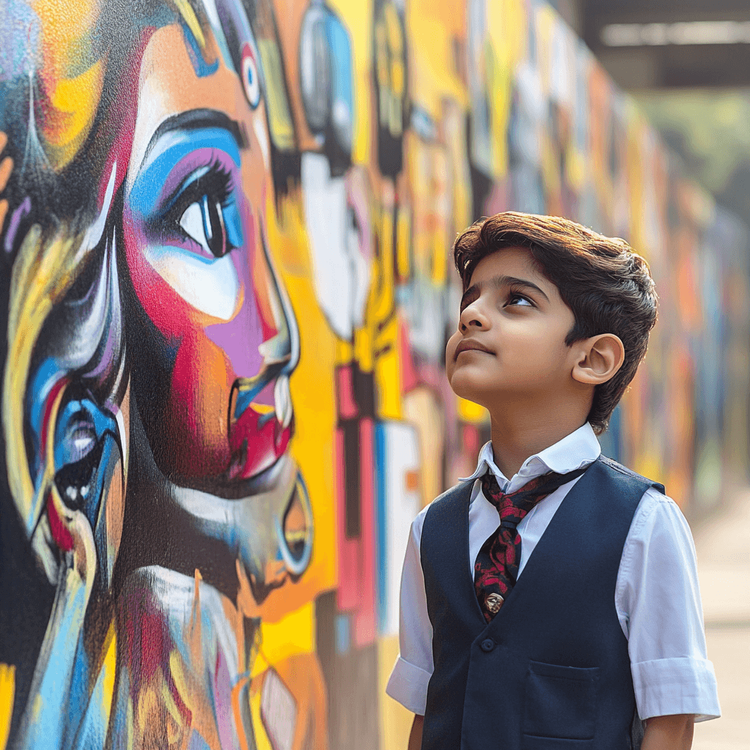Graffiti as Art: Why Street Arts Are Today’s Most Honest Canvases

Table of Contents
- The Origin and Evolution of Graffiti
- Graffiti as a Voice for the Voiceless
- Graffiti and Intellectual Provocation
- Street Art vs. Graffiti: Is There a Difference?
- Global Acceptance and Tourism Around Graffiti
- Artistic Skill and Technique
- Graffiti in Education and Youth Programs
- The Vandalism Argument: A Matter of Context
- The Art-Vandalism Duality: A Case for Subjectivity
- Modern Brands and Institutions Embrace Graffiti
- How Graffiti Can Inspire Children
- Graffiti as a Legacy of Culture and Emotion
- Conclusion
- FAQs:
In a world where self-expression takes many forms, graffiti stands out as one of the boldest and most misunderstood. While some dismiss it as mere vandalism, others celebrate it as revolutionary art. The real debate lies in whether graffiti deserves formal recognition as a legitimate art form.
The Origin and Evolution of Graffiti
Graffiti dates back to ancient civilizations. Archaeologists have discovered wall markings in Pompeii, the Roman Empire, and even Ancient Egypt. But modern graffiti, as we understand it today, originated in the 1970s New York, as part of the hip-hop and counter-culture movements. What started as spray-painted names (tagging) evolved into complex murals, social commentary, and large-scale public artworks.
These expressions were often made anonymously and illegally, but with passion, skill, and intent.
Graffiti as a Voice for the Voiceless
One of the strongest arguments for recognizing graffiti as art is its ability to amplify unheard voices. Graffiti artists often come from marginalized communities or subcultures and use public walls as their canvases because traditional gallery access is limited.
These artworks frequently address:
Poverty
Oppression
Environmental concerns
Corruption
Mental health
War and peace
In this sense, graffiti is not random scribbling - it is protest, poetry, and public engagement combined.
Graffiti and Intellectual Provocation
Much like classic literature that questions society, graffiti challenges norms. It dares viewers to rethink what is acceptable, fair, or even beautiful. This makes graffiti parallel to other controversial art forms, including books that contain offensive or outdated language. The discussion around whether we should edit or censor such texts is similar. If you're interested in this topic, we recommend reading this deep dive:
Should offensive language be removed from works of classic literature?
The point remains: art isn't always comfortable, but it is powerful.
Street Art vs. Graffiti: Is There a Difference?
Yes, and no. While graffiti is often free-form, rebellious, and unauthorized, street art is more likely to be commissioned or approved by local governments or communities. However, both forms often use the same tools (spray paint, stencils, markers) and visual styles.
Many artists, such as:
Banksy (UK)
Shepard Fairey (USA)
Eduardo Kobra (Brazil)
Lady Pink (NYC)
Their works now appear in museums, auctions, and academic discussions.
Global Acceptance and Tourism Around Graffiti
Around the world, entire neighborhoods have transformed into outdoor art galleries. Places like:
Berlin’s East Side Gallery (Germany)
Shoreditch in London
Wynwood Walls in Miami
Hosier Lane in Melbourne
Lodhi Colony in New Delhi
These spots attract tourists, generate local revenue, and create platforms for emerging artists.

Artistic Skill and Technique
It takes planning, precision, color theory, visual storytelling, and innovation to create impactful graffiti. Many graffiti artists spend weeks designing a piece before executing it on walls, trains, or abandoned spaces. From 3D illusions to powerful black-and-white contrasts, graffiti demonstrates artistic mastery.
Just as sculptors mold clay or painters blend oils, graffiti artists experiment with:
Typography and fonts
Layers and shading
Symbolism and cultural references
Political cartoons and caricatures
Graffiti in Education and Youth Programs
Many schools and youth organizations now offer graffiti workshops to promote:
Creativity
Self-expression
Collaboration
Civic engagement
These programs recognize graffiti as a powerful, accessible tool for young people to channel emotion into constructive outlets. They learn to express themselves without fear of judgment or censorship.
The Vandalism Argument: A Matter of Context
Of course, the argument against graffiti centers around property damage and consent. And it's a valid concern. Unauthorized graffiti on private property, historic monuments, or public transport can be disruptive and costly to remove.
However, many cities now create designated graffiti zones, where artists can freely paint without legal repercussions. This approach allows art to flourish without conflict.
So, should graffiti be illegal - or should it be curated?
That’s the evolving question.
The Art-Vandalism Duality: A Case for Subjectivity
Art is inherently subjective. What one viewer sees as defiance, another may see as brilliance. Van Gogh, Picasso, and even Shakespeare were once criticized for being too rebellious for their times. Now they are icons.
Graffiti similarly requires a shift in perception. Instead of focusing solely on legality, we should assess:
Intent
Message
Artistic merit
Impact on society
Modern Brands and Institutions Embrace Graffiti
The commercial world has already embraced graffiti. You’ll now find graffiti-inspired designs in:
Fashion (Dior, Adidas, Supreme)
Film and TV set design
Magazine layouts
Album covers
Hotel interiors
Advertising campaigns
This shows how deeply graffiti has infiltrated mainstream aesthetics, even if laws haven't caught up.

How Graffiti Can Inspire Children
Introducing children to graffiti (in legal, educational settings) can help them:
Learn visual storytelling
Understand urban culture
Value freedom of expression
Respect diverse voices
Find confidence in their perspective
At PlanetSpark, we often encourage learners to explore alternative forms of communication - from storytelling and writing to creative expression. These skills nurture critical thinking and emotional intelligence, just like graffiti does.
Graffiti as a Legacy of Culture and Emotion
Graffiti is more than paint on a wall - it’s a living, breathing journal of urban life. From expressing political dissent to honoring a lost friend, graffiti often captures raw, unfiltered emotion. It documents social struggles, celebrates victories, and immortalizes the voices of those who may otherwise go unheard.
This immediacy makes graffiti more than decoration - it’s dialogue. It sparks reflection and starts conversations. Whether found in alleyways or celebrated art districts, each piece holds a story rooted in truth, place, and identity.
Graffiti doesn’t demand to be understood or even liked. But like all art, it seeks to be seen.
Conclusion
Graffiti has evolved from being a back-alley scribble to becoming the heartbeat of urban identity. It speaks for the marginalized, empowers the youth, provokes debate, and beautifies blank spaces with bold ideas. Yes, it must be done respectfully and with boundaries. But its impact on culture, aesthetics, and identity cannot be denied. So, should graffiti be considered art?
Absolutely.
FAQs:
1. Is graffiti always illegal?
Ans. No. While graffiti is often done without permission, many cities now have legal walls or designated graffiti zones for artists to work on.
2. What makes graffiti different from vandalism?
Ans. Graffiti becomes vandalism when it's done on private or public property without consent. When done with permission, it's considered a valid form of street art.
3. Can graffiti be taught as part of school art programs?
Ans. Yes. Many schools and organizations offer graffiti workshops to promote creativity and teach children how to express themselves safely and legally.
4. Who are some famous graffiti artists?
Ans. Artists like Banksy, Jean-Michel Basquiat, Lady Pink, and Eduardo Kobra are globally recognized for turning graffiti into socially conscious masterpieces.
5. How is graffiti similar to literature in social impact?
Like literature, graffiti reflects society’s values, fears, protests, and hopes. Just as some classic literature contains controversial ideas or offensive language, graffiti often challenges norms. Learn more here:
Personalized Communication Report
Record a video to get a AI generated personalized communication report for your child

Hi There, want to try these
tips for your child with
LIVE with our expert coach?
Let's check your child's
English fluency
